In Japanese, å¡Šã¾ã‚Š katamari refers to a lump or a mass of substance, made famous by the hit PS2 game Katamari Damacy about an alien prince trying to roll the entire planet up into a ball. Don’t ask.
Today’s lesson will not focus on any particular topic. Instead, we will take a look at some of the interesting things you can find in the Japanese language, things that you probably won’t find in a textbook. Maybe. In a sense, I’m lumping all the small miscellaneous topics into a katamari. I’ll probably include a Katamari chapter every few lessons.
Okay, so that’s really just an excuse for me to write a really short chapter of randomness because I am sort of busy this week.
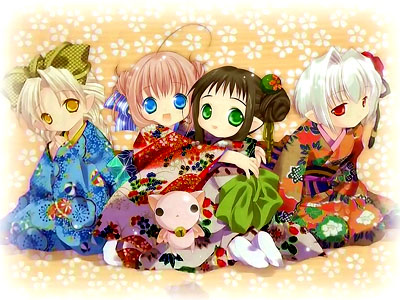
On another note, Katamari chapters will not have any theme character but instead have a variety of pictures from various forgotten directories on my computer. I bet an archaeologist can publish a few books just by digging through my hard drives.
Your nominations from last week will carry on to next chapter.
“Big” Numbers
You have probably seen the kanji used for counting in Japanese, but if you had ever been to a bank in Japan or signed a legal contract in Japanese, you would have noticed some weird and complicated-looking kanji, such as the ones in the right column below.
| 一 (ichi) | one | 壱 |
| 二 (ni) | two | å¼ |
| 三 (san) | three | å‚ |
| 四 (shi or yon) | four | 肆 |
| 五 (go) | five | ä¼ |
| å… (roku) | six | 陸 |
| 七 (shichi or nana) | seven | 漆 |
| å…« (hachi) | eight | æŒ |
| ä¹ (kyuu or ku) | nine | 玖 |
| å (jyuu) | ten | 拾 |
| 百 (hyaku) | hundred | 佰 |
| åƒ (sen) | thousand | 阡 |
| 万 (man) | ten thousand | è¬ |
These kanji are called å¤§å— (daiji), literally “big words”, and they are used in legal documents to make the numbers difficult to modify and thus prevent cheating. The difference between 一 (one) and 二 (two) is just another stroke, but there’s no way to change 壱 (one) into å¼ (two). The readings stay the same for both versions.
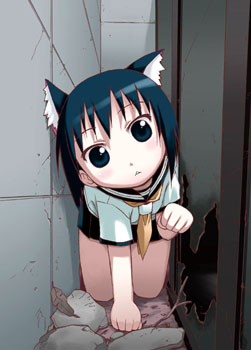
Some manga and anime use daiji for the “looks cool” effect. Examples include the manga of Ikkitousen and Kannadzuki no Miko, both which used daiji to number their volumes. The end result is that some foreign fans can’t tell the order of the books. Oh well… å¼ certainly looks better than two little horizontal strokes, though. :3
Speaking of Kannadzuki, that brings me to the next topic…
Old Japanese Months
Look up ANN’s listing for 神無月ã®å·«å¥³ (Kannadzuki no Miko) and you’ll see that one of the translations for the title is “Priestesses of the Godless Month”. AniDB has it as “Priestesses of a Godless Moon“. The kanji 月 can refer to both a month and the moon, but what exactly does “kannadzuki” refer to?
The answer: October (therefore ANN’s translation is more appropriate)
But why is October called the “godless month”? For that we have to refer to the old Japanese names for the different months.
| January | ç¦æœˆ (mutsuki) |
| February | 如月 (kisaragi) |
| March | 弥生 (yayoi) |
| April | å¯æœˆ (udzuki) |
| May | çšæœˆ (satsuki) |
| June | 水無月 (minadzuki) |
| July | 文月 (fumidzuki) |
| August | 葉月 (hadzuki) |
| September | 長月 (nagatsuki) |
| October | 神無月 (kannadzuki) |
| November | 霜月 (shimotsuki) |
| December | 師走 (shiwasu) |
Modern months use number + gatsu, for example August is 八月 (hachigatsu), literally “the 8th month”. However, the old Japanese calendar uses months with symbolic names that were relevant to the people of that time.
It is believed that all the Shinto gods gather in the province of Idzumo (part of modern day Shimane prefecture) for a meeting every year in October. Therefore, most of Japan is left “godless” and October is known as the “godless month”. In Idzumo, October in the old calendar is called 神有月ï¼ç¥žåœ¨æœˆ (kamiaridzuki), literally “the month with gods”.
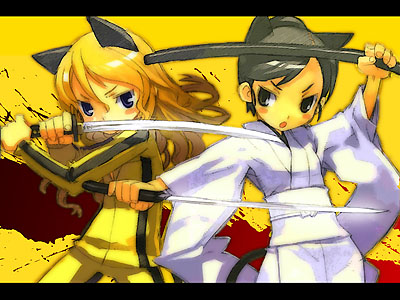
Other references to the old Japanese months in anime and manga include Happy Lesson and Azumanga Daioh.
Happy Lesson in particular has almost every single female character named after a month, with the five main heroines being Mutsuki, Kisaragi, Yayoi, Satsuki and Udzuki, or January to May. Kisaragi~~~ :3
In episode 17 of Azumanga, a joke involving “shiwasu” (December) was made in reference to Yukari-sensei running. The kanji for shiwasu consists of 師 (teacher) and èµ° (run), but 師 also refers to monks and priests in older context. The name came from the fact that December is a busy time and even monks and priests, who are normally calm and composed, have to rush around running to get preparations done for the coming new year.
Pronouns
Japanese people don’t like to use pronouns. That said, they have an awful lot of them. Depending on the context and the other person’s relationship to you, you have to determine which pronoun is more suitable. All examples below are based on anime, games and manga and may not reflect Real Life ™.
Some pronouns for “I/me” and what they say about the speaker:
ç§ (watashi) – most commonly-used, generally neutral
ç§ (atashi) – girls and guys-who-want-to-be-girls only
ç§ (watakushi) – rich old men, butlers and princesses
僕 (boku) – female or male prepubescent children or young boys
俺 (ore) – male and asserting one’s manliness
ã‚ã— (washi) – old men nearing death bed
ã†ã¡ (uchi) – female and speaking with an accent
å·± (ora) – rural, i.e. farmers
ãŠã„ら (oira) – same as above, see: Rakushun from Juuni Kokuki
拙者 (sessha) – ninja or samurai, see: Kaede from Negima!
我輩 (wagahai) – male and arrogant, see: Keroro from Keroro Gunsou
In general, you should use “watashi” if you have no idea what you are doing.
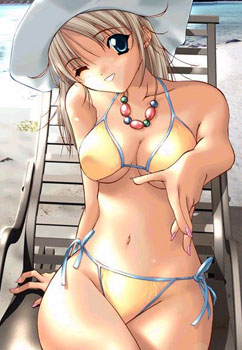
Some pronouns for “you” and what they say about the other person:
è²´æ–¹ (anata) – more or less generic, also used by wives to call their husbands
貴女 (anata) – the person is female
ã‚ん㟠(anta) – shorter form of anata, may sound rude
å› (kimi) – female, or a lower-ranking person in a work environment
ãŠå‰ (omae) – your pet, someone very close to you or someone you hate
å·± (onore) – someone you really hate, possibly about to be hit by you
貴様 (kisama) – see above
æ± (nanji) – thou, see: Mai-Otome (waga na ni oite nanji no chikara wo…)
其方 (sonata) – archaic and similar to thou, see: Lafiel from Seikai series
ã¦ã‚㈠(temee) – someone you really hate, you might be yakuza.
ãŠå®… (otaku) – someone emotionally distant and unknown to you
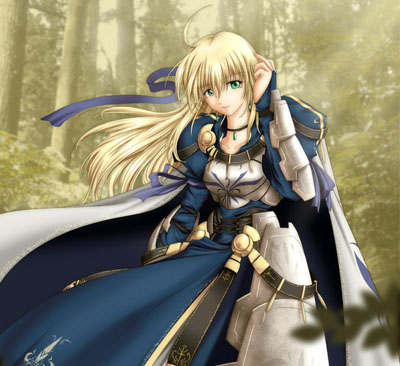
In general, anything that is supposed to be used for people who are intimate with you can sound really rude and/or insulting when used on a stranger or someone you hate. Weird but that’s how it goes.
The safest bet when you are not sure is to not use any pronouns at all when possible. Use name + san if you know the person’s family name. If you really absolutely have to say “you”, then “anata” is probably the safest bet. Just don’t cry if you get punched in the face (well maybe not that bad).
Conclusion
In the fourth chapter, we talked about:
- numbers used in legal documents
- old Japanese months
- pronouns
- this chapter is really short because I am busy
- I padded the post with useless pictures
I promise the next chapter will be longer. Hopefully.
Hey, at least this time I did try to talk about things that are related to anime. Yay(?)
On a final note, instead of just nominating a girl for the next chapter, you can also give some suggestions on what I should talk about. Tentatively it’s going to be about adjectives, but that’s just not much fun…
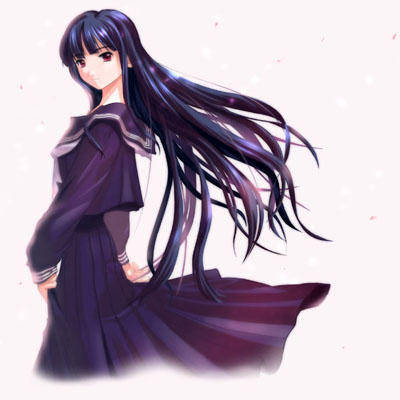

Some additional personal pronouns:
Chin: used exclusively in imperial edicts. “Chin omou ni…” roughly corresponds to “We, the emperor declare…”
Yo: nowadays it’s used only in samurai dramas and in some anime. For example, Reinhard in Legend of Galaxy Heroes addresses himself as “yo”.
Kei
Kikan
Onushi: outdated pronouns meaning “you”. Attempting to use them in a real life conversation would result in you becoming a laughingstock.
They may appear in period dramas and quasi-historical anime.
It’s quite interesting by the way that many of these 2nd person pronouns that became rude or insulting in modern usage were actually honorific forms. Like “kimi”, which was used to address members of the royal family (“himegimi”, meaning “princess”, can be heard in some anime), or “omae”, which used to be a polite way of referring to “(the person standing) in front of (me)”. Likely, “kisama” has the “-sama” honorific postfix.
Yes, so many levels of politeness that there’s different ways of saying “I” and some of those listed definitely don’t show up in textbooks. It’s one of the things Chinese Japanese learners have problems with along with Keigo and how Kanji has two pronounciations.
As for the formal numbers and months, you can really look them up in something like JWPce so it shouldn’t confuse those already proficient in JP. Background story was interesting, though :)
Just wondering… How long has everyone who knows JP been learning the language for? And… Did you learn it to understand Japanese stuff (i.e., Anime/Manga/Games)?
Btw, what happened to your Suzumiya figure post? Was going to post this mouse mat there :P
http://www.animaxis.com/en/shop/product.asp?sku=140737%2D00
And I’m surprised you didn’t write something about the ending of the series too since you were following it up for a while.
Keep the posts comin’.. I’m too absent minded to regularly get my learn on, so your little lessons keep giving me a nudge when i forget
Interesting post; I learned quite a bit.
Maybe one of these days, you can do a post on slang. Or a post on the different dialects of Japanese. Or a post on Japanese name pronunciations. :)
Well I supposed the ending of the series was nice but I had read the novel and it wasn’t a surprise to me anymore.
That said, remember how I predicted that Yuuutsu, the first novel, would last for the entire series? Pffft and people didn’t believe me. >_<
Asuka: I’ve been intending to do one on Japanese names, but I have no idea where I should begin. I don’t even know if it’s possible to teach anything about how to read Japanese names because there are very few general guidelines that you can follow.
With regards to dialects, I can more or less understand them but I can’t explain how they work.
Well…this is a basic course…so er…i guess teaching ã•ã›ã‚‹, or ã•ã›ã‚‹, or ãˆã°, or 出æ¥ã‚‹ and stuff is out right? >_
so how about teaching what we learnt when we were in basics….like counters. iPpiki, niHhiki,sanBbiki and which counters are used for which objects and maybe include hitotsu to too. or you can teach the readings of the japanese calender or the age of pple (hatachi) just a suggestion^^.
Next Girl I want for the lesson is RURI from ナデシコï¼
Pingback: Ramblings of DarkMirage - Anime, Games, J-Pop and Whatever Else » Blog Archive » Japanese Titbits #1 - é»„æ˜ (tasogare)
ã¦ã‚㈠comes from æ‰‹å‰ in the same way ã™ã’㈠comes from 凄ㄠor ãŠã‚‚ã—れ㈠from é¢ç™½ã„ and how most any word-final diphthong can become ã‡ãˆ.
Also, it may be important to mention that many of the personal nouns (they’re not properly “pronouns”) can be used to mean either “I” or “you” (e.g. ãŠå‰) and frequently these ones are, or used to be, humble or polite in reference to one’s self but are quite rude when used to refer to others. å…± (ã¨ã‚‚) is another example of one that can be humble or rude depending on who you’re talking about.
Late to the party, but I have to mention a few things.
Atashi, which is said by people such as Sara of “Love Hina” and Capcom’s Sakura, is actually written in just hiragana as in ã‚ãŸã—.
Ware/waga/我 is not always seen as a cocky pronoun for I. Now, yes, there are cocky people like “Justice Gakuen’s” Kurou that use ware and waga. Capcom’s Gai/Guy uses this form all the time also.
Boku is actually said by men, regardless of age.
Uchi is said by people in the Kansai region and not just women. I believe Sendou of “Hajime no Ippo” uses “uchi”, but it’s been a few years since I last saw it. I should be right here though.
Atai, which uses the same kanji as “watashi” and the like, is a form that’s hardly said overall and is said by women. The two characters I can think of that use this form are Zaki of “Justice Gakuen” and Ayame of “Power Stone”. Wow. I use Capcom characters a lot, don’t I?
That’s all for now.
Just wondering what is the sauce for the 27_katamari3.jpg image? (first nekomimi)
Quote
“In general, anything that is supposed to be used for people who are intimate with you can sound really rude and/or insulting when used on a stranger or someone you hate. Weird but that’s how it goes.”
Isnt it the same in other languages? At least in spore, its ok to call close friends “Oi” or nicknames, but not strangers.
Obama offered his own budget earlier this year. It actually increased spending and was universally rejected by the senate 97 to 0
——————–